FROM THE ARCHIVES
Back in 1991, THM was privileged to publish this piece by Gabriela Grillo. Gabriela played a key rôle in the development of the Kür, as a rider, but also as a theorist, as a trained musician who worked to combine the classical principles of dressage with music that was appropriate and sympathetic…
An essay by Gabriela Grillo (this article originally appeared in the American journal – Dressage & CT)
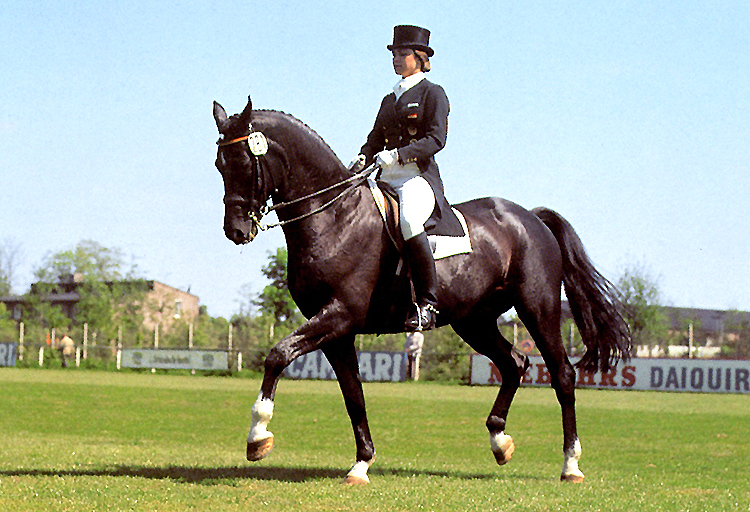
With Freestyle to Music now a Championship – and an Olympic event, we are proud to publish an essay by Gabriela Grillo, the rider-cum-musicologist, who through her own entrancing Freestyle performances, did so much to create an audience for the new equestrian art. Gabriela Grillo was a member of the gold medal winning German Olympic team at Montreal – and her performance in the Freestyle at Lausanne on Ultimo, is a video treasure, replayed countless times, and every time the walk pirouette flows effortlessly into canter pirouette, it takes the breath away.
Whenever one starts to think about something, it’s like throwing a pebble in water, which makes a lot of rings. In other words, as soon as one finds the answer to a question, new questions appear.
It’s the same with the Kür. To formulate a concept of it, one must not only study its present development, but also trace its roots in order to find a key to its future development. This all leads to a certain philosophy – a philosophy about riding, and about riding to music, in particular.
When discussing riding to music, we must backtrack a lot, actually to the times of Xenophon. Though one could go back even further, Xenophon is a perfect point of departure for the study of the history of riding. But before we embark upon this historical excursion, which will give us a feel for the cultural stream we are standing in and bring us to the present practices, let us consider our problem from the most distant ring that formed in the water when we threw our pebble into it – the ring that represents the philosophy behind everything.

PHILOSOPHY
In everything we do, we have to accept a certain law, which I would like to call the tree symbol. Any development that is healthy and able to survive has its roots in the past, is a living plant in the present, and should have leaves in the future.
Accepting the tree symbol, caring for the roots, the plant and the leaves means to take on a lot of responsibility. For a rider, this means to be responsible for learning to work with a living creature, training it in the classical way passed on to us over the centuries, maintaining this heritage and finally, passing it on. With that, he is also responsible to other riders so they will receive this heritage unspoiled, so they will, in turn, pass it on in its pure form so as to guarantee its continuity.
All this culminates in the responsibility for the horses, their natural development on the classical base, their place in sport in our century, and by continuing and hopefully refining it, their status in the future.
This responsibility leads to the essentials of the Kür – the classical ride to music that shows the beauty and harmony of dressage – a form of art that can be enjoyed by everyone. In the Kür, we combine the historical aspects concerning elements, style and purpose with artistic expression. When presenting classical dressage to music, it’s like a ballet on horseback with a beneficial result for rider and horse.
This means not only schooling the rhythm and training the fantasy, but also trying to represent the combination at its best, learning about the partner, and developing sensitivity.
Thus the Kür can add a lot of aspects to the philosophy of riding. To get a better feeling about its renaissance and more motivation for its desirable development in the future, let’s take a look at its history.
HISTORY
As a starting point, let’s take the first famous riding master whose name has survived to our days – the Athenian Xenophon.
Xenophon was not only a Greek historian and philosophical essayist, but also one of the first that took the initiative to study other riders, the art of horsemanship, and put his observations in the form of a book, Hippike, with the idea of passing them to other horsemen. In fact, Xenophon studied the Iberian cavalry because he admired their ability of fast and exact manoeuvres.
Looking at it from the historical perspective, whether we like it or not, the development of culture and the expansion of nations from the times when humanity domesticated the horse until the 20th century depended primarily on the strength and power of the cavalry. And from this came the importance and influence of the cavalry masters and the riders at the courts of all nations.
Historically, it is a universal custom to celebrate special days and special events with demonstrations of power, joy, strength, and so on. So it was among the Greeks in Xenophon’s time and in ancient Rome as well as with every other people, that great victories and important religious observances be celebrated by the show of strength of their cavalry. This demonstrated its importance as the guarantor of their security and its ability to expand its domain.
Among the ancient tribes of Europe and Asia, the cavalry performed ritual rides on religious days. These were held, for instance, around the grave of a hero with their tribe, or with cavalry presentations showing off manoeuvres. This was always accompanied by music, which in those days was performed on all kinds of trumpets and drums (nowadays called ‘the classical open air music’), which is amply documented on surviving Greek and Roman stone carvings.
From these times came the Latin verb tornare, or the Old German word turnam, which means fast turning with the horses. From this in the Middle Ages evolved the word tournament. In the Middle Ages, the tournaments were always opened and closed with parades that were accompanied by open air music, as were the presentations of the participating knights and their horses.
Of course, the tournament cannot be compared at all with today’s dressage or the very fast manoeuvres of ancient cavalry.
One has to keep in mind how heavy the armour was, that the knights wore, therefore, the horses had to be a heavier, cold blooded types. In the later Middle Ages, the horses were also covered with armour, so normally the single fight – the so-called jousting – as well as the training fights performed in groups were more or less a run against each other, starting at the walk and reaching the canter as soon as possible. It was very dangerous and also a bit clumsy since reports by contemporaries tell us about many knights that were killed not in combat, but from falling off the horse and not being able to stand up unassisted. Many of the knights died because their helpers were not with them in time to get their helmet off to allow them to breathe. This led to a Papal edict forbidding tournaments, and for a short time they were replaced by jousting done with weapons that were not as dangerous – some sort of fight that we find later in the carousels, which means a fight that shows the manoeuvre, but is not a real fight of person against person or group against group.
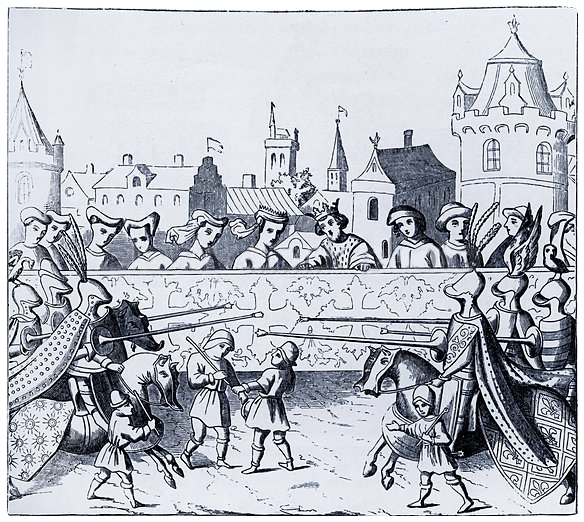
The Papal edict was rescinded shortly before the Crusades because the European League thought their knights should be better trained to go to the Holy Land. From our point of interest, the tournaments were another equestrian event where music was an important part of the parades at the beginning and end of the event.
With the introduction of firearms in warfare, and the beginning of the Italian Renaissance, the style of riding had to be changed. This was for the very simple reason the riders and the cavalry wanted to survive, and the knights with their heavy horses and a lot of armour were unable to outmanoeuvre their opponents with fire weapons, which could easily penetrate the armour. Consequently, they not only had to change their strategy, but had to return to lighter, more agile types of horses.
The riders were forced to use a much lighter personal protection as not to hinder the horses in performing manoeuvres that contributed more to their defence than heavy armour and we think it was the Spanish horse that filled these needs.
It’s interesting to note that after Xenophon we have no record of writings by riding masters until the Renaissance. The first book that reached us after Xenophon’s Hippike is Gli Ordini de Cavalcare (The Rules of Riding) published in 1561 by Frederico Grisone, the founder of the School of Naples. We know prior to Grisone, there was an Iberian horseman, Dom Duarte da Gama, who was the first in our era to write about riding art, but his work has not yet emerged in modern times, although there is a possibility that a manuscript may have survived.
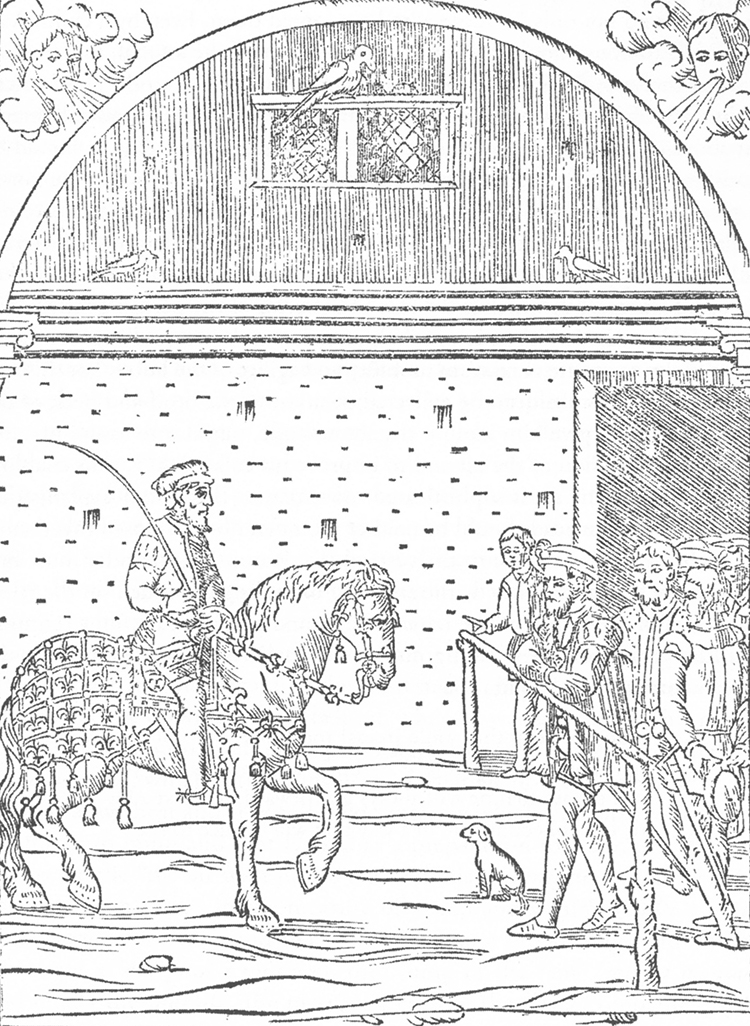
Grisone was still a medieval man – you just have to look at the bits he used – they were somewhat torture instruments, but if one considers the heavy armour of the knights and the heavy horses, it was not easy for them to achieve a real control. But with the lighter type of horse and the agile rider, the rules about riding changed.
This led to the times of Pluvinel, Guerniere and others who followed them, but we still must return to Xenophon’s Hippike, which is as valid today as it was almost two and a half millenium ago.
As already stated, the Middle Ages were followed by the Italian Renaissance, which as the name says, strived for a revival of the glories of Antiquity. As a result, the various courts of Italy started to imitate the celebrations of ancient times in which cavalry had always played an important role. Of course, music was an important part of such celebrations. Thus, during the Renaissance they attempted to find a possibility to show riders and horses, with musical accompaniment, as a group executing choreographed manoeuvres.
What started as imitations of Roman triumphs at the courts of Renaissance Italy continued into the baroque period in the rest of Europe. It was during this time the first forms of carousels appeared, and then in the seventeenth century the art form that is especially interesting to us- the horse ballets.
The carousels usually included a parade followed by fights on horseback, but in a choreographed form. These were not fights of man against man as in tournaments, but rather sports in which one could gain points in some sort of game. These included trying to pierce rings or wooden heads with a lance, or cutting objects off with a sword. In short, they were rather harmless games without any danger of physical harm to the participants.
In Italy at the courts, especially at the court of the Medici in Florence, a form of the ‘festa a cavallo’ – the festival of horses- was originated using the ingredients of the tournaments, but giving it a real story. Thus the cradle of the horse ballets is at the court of the Medici in Florence because it is there the plays with a theme were invented. Normally a theme from allegory or sagas, where they would choreograph fights and everything would end up in a parade or whatever you will call it, in harmony and peace.
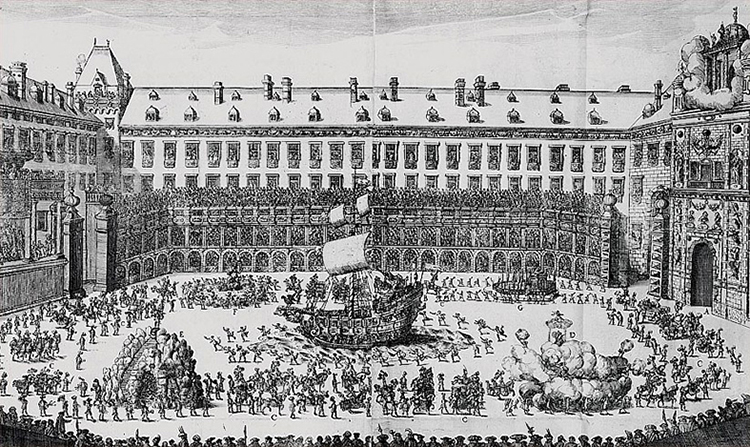
This led to the horse ballets that were celebrated all over Europe, many of them almost operas on horseback. There were choirs, singers, dancers, and people that would walk in and escort the riders. And, of course, there were riders in quadrilles, the theme of which was based on some allegory or saga. They would show a fight and at the end a so-called ‘deus ex-machina’ (ie. some person representing eternity) would show up and say ‘You don’t have to fight each other to honour the ruler of this court’ or ‘Because we were celebrating a wedding, you should all be at peace with each other’.
The quadrilles would together perform a horse dance. This was the specialty, and gave the whole form its name. The composers of the court would write music especially for the horses’ performances. This music was based on the music used in dances for people, but of course, only those types of dances that would fit the gaits of the horses were used. A choreographer would design the patterns to that music so they really had a ballet on horseback. This was the culminating point of such festivity, and it gave the whole form its name.
The most famous, biggest and glorious horse ballet took place in Vienna in 1667, and as far as we know, more than 600 horses and about 1,300 people participated in it. It was performed to celebrate the wedding of the Emperor Leopold I to his Spanish bride, Infanta Margarita Theresa.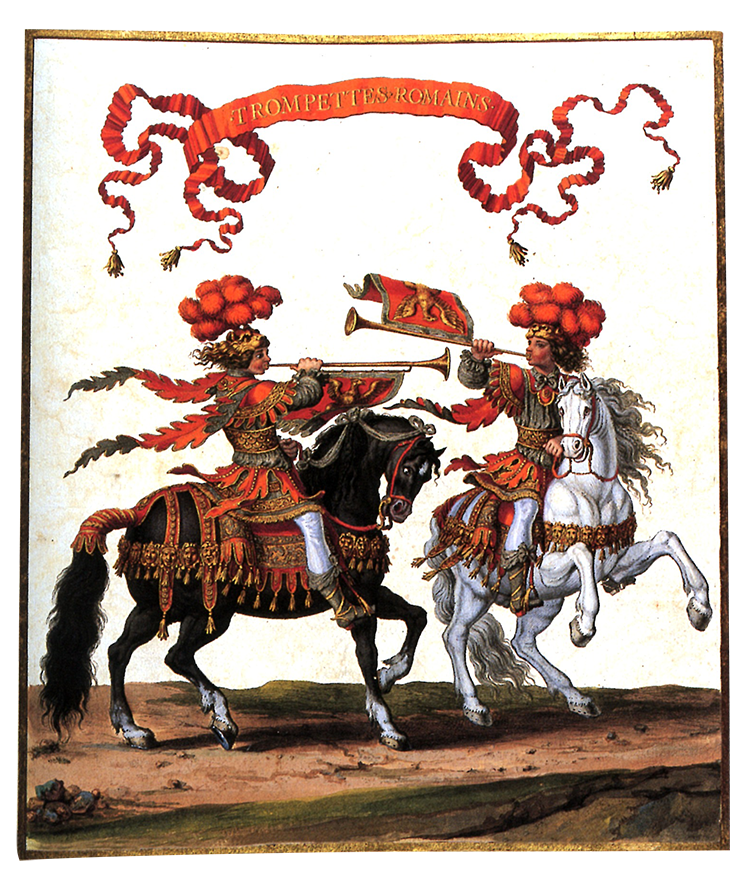
It was called ‘La contesa dell’ aria del l’acqua’ (the fight of the air against the water) and each element was supported by either fire or earth. This was the fight of the four elements, and the question was who had the main influence in creating the pearl. By the end of the spectacle, ‘eternity’ showed up and said, ‘The pearl of pearls is the bride, so the master of the elements is her husband. You don’t have to fight any longer. You can join together and celebrate the crown of pearls and her husband’.
In this ballet, the emperor showed up on his horse, prancing and courbetting in front of the Empress. The choreography, the music, the whole ballet has been preserved to this day as are engravings of the event – it must have been a marvelous thing.
One little anecdote aside – five years earlier the French court celebrated a big, two day carousel with 500 horses participating, and the theme was the five continents. But the 1667 horse ballet at the Austrian court was not only bigger and more expensive, it celebrated the Emperor as the Master of the Elements. While the French Sun King was depicted as the Master of the Earth and its nations – the Emperor was celebrated as the Master of the Elements themselves!
Thus all these festivities were not only a display of joy but also had some political implications, such as to show their court was especially mighty, that it was the leading court and so on and so forth.
Those organizing a successful horse ballet at the Austrian court were at an advantage since they had good connections to the court of the Medici. Famous artists of the ‘festa a cavallo’ in Italy were called to the Austrian court to help plan the big event.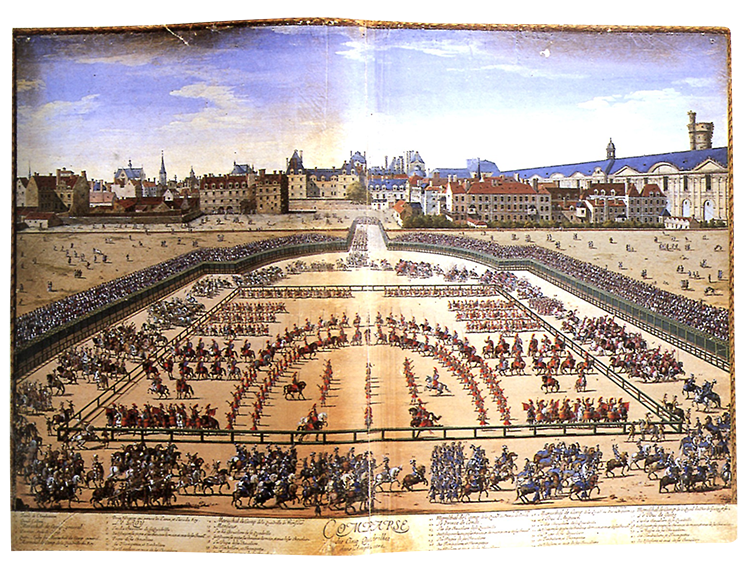
With this ballet on horseback also began an era when an orchestra would provide the music. Earlier, only plain open air instruments like drums and trumpets were used. In Vienna, they added clarinets and violins and this signalled a new form of presenting riding art. Now, instead of just a parade, real dances were adopted, and so they had a real dance form with the horses.
But this extravaganza in Vienna also heralded that the era of the horse ballet was coming to an end since it became very difficult for other courts to outdo it. Consequently, after 1667 only very few horse ballets are mentioned. Instead, the era of the carousels returned, and it came into full bloom during the 18th and 19th centuries. The carousels were now not limited to those performed on horseback, but also included those with coaches and sleighs.
Much of the information we have about them comes from the Spanish Court Riding School in Vienna, thus they must have been mostly indoor events musically accompanied by an orchestra. At the end of the carousels, the participants would join together to perform a dance-like quadrille.
The end of the 19th century signaled the end of the era of carousels. As they were moving out of farming, out of the mainstream of economic activity, horses and riders entered the realm of sport when in the Stockholm Olympic Games of 1912, the equestrian disciplines were first made part of the official program.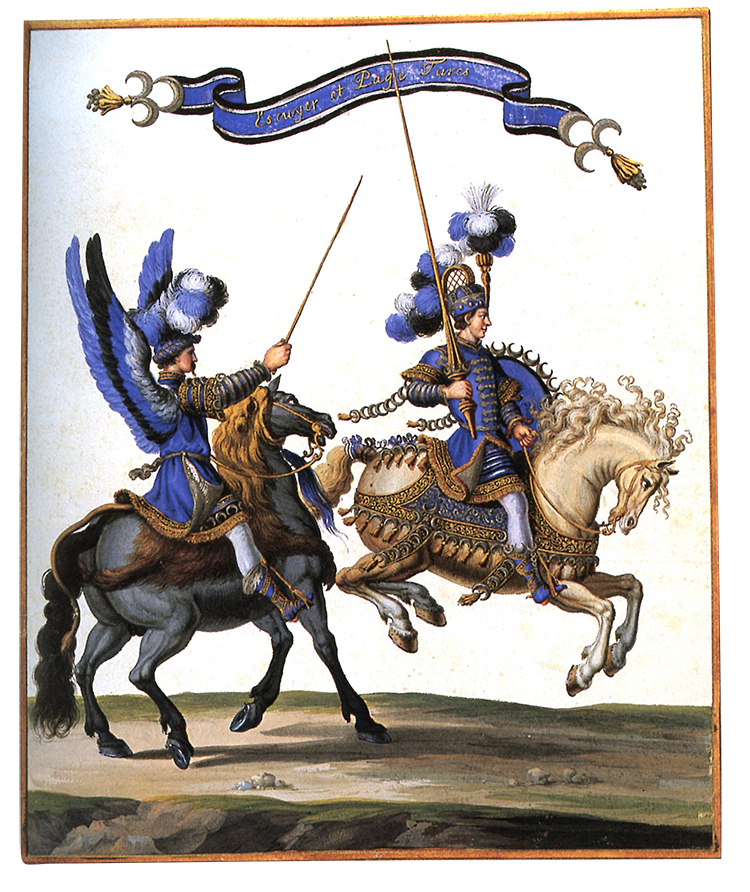
Then came World War I, after which few courts survived, particularly in Central Europe where the carousel was perhaps most popular. Twenty years later the second catastrophe, World War II, changed the face of Europe even more, and this brings us to the present status of the horse.
The history of the art of riding is preserved in the books of the masters. Whenever the art of riding became important to a court, or a court became important in history, its cavalry and, consequently, its riding masters, were generally especially good people and, of course, they would try to record their knowledge. Therefore, such works are not only records of the development of the art of riding, but also the development of a people’s culture, political ambitions, and history.

At the 1972 Olympic Games in Munich, Germany’s leading dressage riders came together to perform a Quadrille. They were: Reiner Klimke and York, Liselott Linsenhoff and Piaff, Wolgang Haug and Lorlot, Karin Schlüter and Liostro, Josef Neckermann and Venetia, Ilsebell Becher and Mitsouko, Willi Schultheis and Armagnac, Inge Theodorescu and Marzio, Walter Günther and Partisan, Gabriela Grillo and Honduras, Harry Boldt and Ariadne and Eva-Maria Pracht and Mazepa.
For example, everybody knows that the Sun King, Louis XIV, was a very proud man as was his father, Louis Xlll. When Antoine de Pluvinel was writing his Manege du Roy (The Royal Riding School), he could only publish it with the permission of the court, and the whole book is a dialogue between the king and the riding master. In the book, the king always says. ‘Monsieur Pluvinel, could you explain to me,’ and Pluvinel very politely answers, ‘Sire…’ but he is the one who tells the king what to do, which means that the riding master must have been a very important and honoured person at the court.
Thus music was always closely related to the art of riding, especially at the courts of Europe. With the demise of most of them in this century, we have arrived at its present status but that present status draws on the traditions of the horse ballets and carousels of the European courts.
DRESSAGE AND MUSIC TODAY
But history of the art of riding is not lost. Its traditions survive in relics, like the Spanish (formerly Court) Riding School in Vienna, Austria; the Cadre Noir in Saumur, France; the Escuela Andaluca del Arte Ecuestre in Jerez de Ia Frontera, Spain; in places like Alter Royal in Portugal. It is kept alive in quadrilles (which led to a discussion as to whether the quadrille should become the subject of a team competition for a national championship). We know the pas de deux, pas de quatre, the solo Ktir, and all this led to a new wave – the World Cup of Dressage.
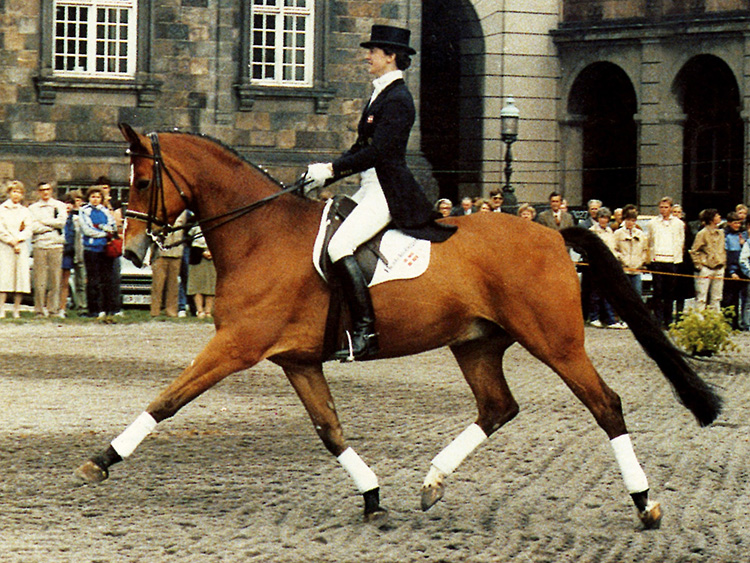
Marzog and Anne Grethe Jensen, winners of the first World Cup final
Remember, the status of the horse in the 20th century has changed. We all know the reason why: because of mechanization, the horse is no longer primarily a working animal in the traditional sense. And since we do not wish to see horses only in the zoo, we have decided they should be maintained as a part of our society, as a partner to humans in sport. While, like everything, there are always good and bad aspects, sport is the way to keep horses an integral part of our civilization.
Our duty is to work on the good aspects and try more and more to eliminate the bad ones. One way for dressage to work on the good aspects should be through the World Cup. The idea of the Dressage World Cup was to find a counterpart to the Showjumping Volvo World Cup. The idea was not to create yet another form of championship, but to promote a so-far rather underestimated form of dressage, the Kür with music, which in turn would help promote the sport, make it more popular, and gain it new friends.
Through the Kür, ridden with a classically trained horse, we raise the test to an even higher level than the Grand Prix, the Kür is in a higher realm of Art. With a knowledge of history and classical basics of dressage, one can hardly agree with those who condemn the Kür as show or circus, for not being classical, or for being a danger to dressage. One should only take these arguments as a warning that the World Cup and/or the Kür should not stray from the principles of classical riding.
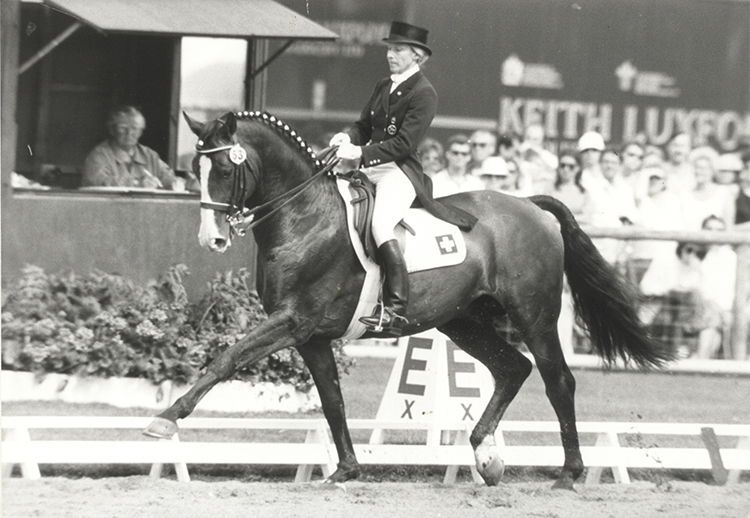
Christine Stückelberger on Gaugin de Lully, winners of the World Cup in 1987 and 1988
The World Cup Committee added a paragraph to the rules that prevents any movement that is not classical, for instance, it forbids piaffe backwards. It states clearly that any movement that is not a part of the Grand Prix test is not allowed to be shown and will lead to the elimination of the rider. The airs above the ground, as shown at the Vienna School, are obviously classical, but they are not allowed. This, of course, does not mean that one is not allowed to show piaffe-pirouette, half pass in passage, or double canter pirouette. All movements that are based on movements in the Grand Prix test are now allowed.
Anyway, a good idea should not be killed by initial problems. Therefore, the Dressage World Cup led to more discussions amongst the national federations and also to discussions on the FEI level.
For instance, the German Federation held a brainstorming session with judges, riders, trainers and organizers. They prepared a paper with regulations for every level, concerning the arena, the time, the judging, the music, the required movements, and developed score sheets with a very interesting ‘collective marks’ score for artistic impressions divided into three separate scores.
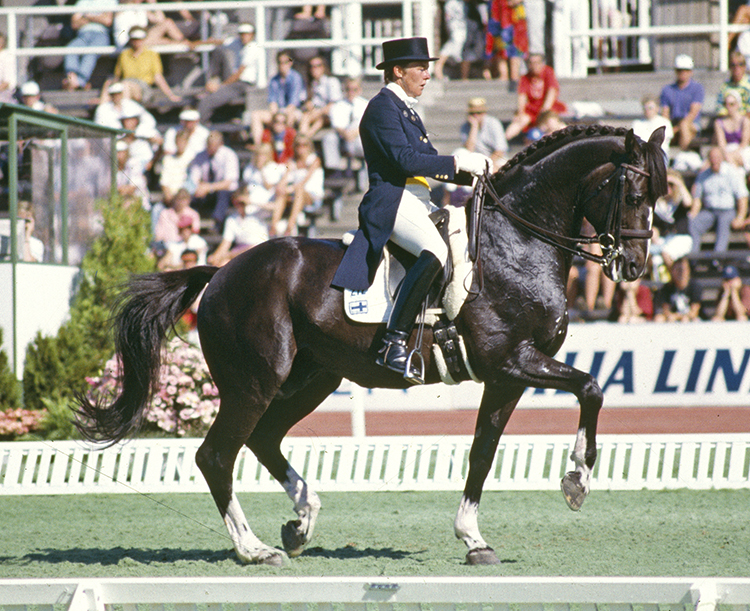 Matador and Kyra Kyrkland, World Cup winners 1991
Matador and Kyra Kyrkland, World Cup winners 1991
The first score sums up the artistic impression of the horse gained by the classical presentation of the movements. It includes rhythm, energy, elasticity, and has a coefficient of three. The second score sums up the artistic impression of the rider. He gains in artistic score and it includes presentation of the rider and harmony, also with a coefficient of three. The third score is divided into three parts a) choreography; b) degree of difficulty, and; c) music, with a coefficient of 10. It can be expressed in decimal scores. The third score is divided into three parts to help the judges really show where they appreciate or criticize the Kür and thereby, help the rider to work out weak points or find out where the weak points in his Kür are.
The discussions will go on, and hopefully they will lead to the fact that Kür should not be a revolution within the scene, but becomes an evolution for dressage. Today’s standard of the Kür, while making its way through difficulties and problems, has established itself and it is clear that the spectators favor it, and therefore, organizers and sponsors prefer it.
The Kür is both loved and hated. For the riders it is, on one hand, a great challenge and a lot of joy if it works, but on the other, it takes an awful lot of work to get to that point. For the judges, it’s the test that is the most difficult to score. But problems are there to be solved, and looking at it objectively, the Kür can be beneficial to all of us, last but not least the horses. By its nature the Kür trains the riders to feel the horse’s rhythm and work with that rhythm – rather than imposing the rider’s rhythm on the horse. The rider also relaxes and rides more sensitively when riding to music – and the horses themselves do respond to the music.
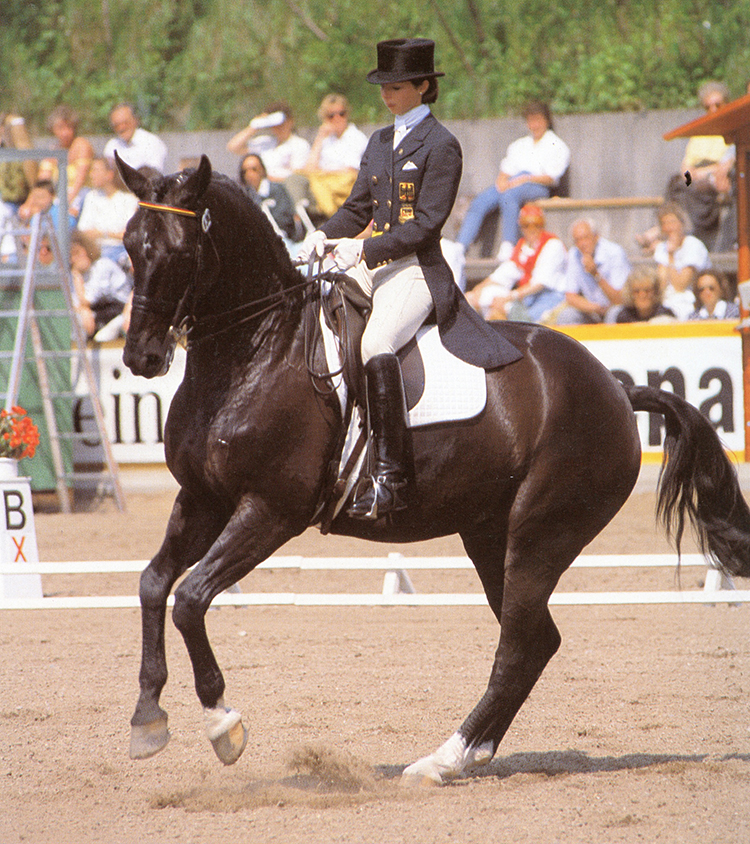
Monica Theodorescu and Ganimedes, winners in 1993 and 1994. Monica is the current German Dressage Team Trainer, 2019
This leads to the prospects for the future. As I already pointed out, the Kür might become a good vehicle for developing the art of classical dressage and thereby promoting our sport.
Consequently, the riders must develop sensitivity for their partners – the horses. We have to train our sensitivity for their gaits, their character, mentality, ability – their personality on the whole. That’s why I said it’s beneficial. The Kür helps the horse because the rider must understand the physical and mental capacities of the horse and work with them. Preparing a Kür the rider must think about the horse and what he can do. By comparison in a Special you have no such opportunity because the movements are all written down – in the Kür you must know your partner, or you will lose points for asking too much.
Let us finally go over how to combine philosophy and tradition, the classical art of riding, stylish music, and the practice of freestyle.
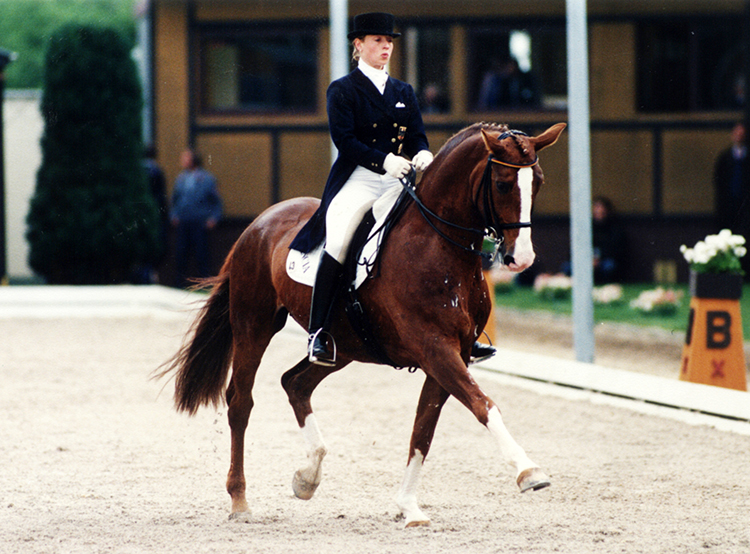
Isabell Werth and Fabienne, winners in 1992
CHOREOGRAPHY
The whole choreography should show harmony. Here we need a balance of space and time, of patterns and movements. On the other hand, if the choreography asks for creativity, it should be obvious.
The transitions between gaits in the Kür do not necessarily have to be performed at letters, but I prefer a Kür that shows transitions at letters because it looks more polished.
There are problems in planning a choreography. We must deal with the time allowed and the required movements. It’s not easy to let the imagination go and then compress all of the movements you have in mind into the time frame at your disposal.
When talking about creativity, ride patterns that express the so-called rider’s language.
For example, if you ride a zig-zag half pass through the diagonal, it should be ridden in such a way that the judge can see the pattern clearly. Sometimes one sees shoulder-in or haunches-in that are not ridden correctly. This doesn’t allow the judge to make up his mind in time regarding what the rider wanted to show.
The question brought up in discussions with judges is that of corrections. In a Kür, there is a possibility should one make, for example, a mistake in the one tempi changes, to use another diagonal to repeat them and better their score. The problem is that within the time frame allowed, in a very well balanced choreography, one normally does not have the time to plan for corrections.
Perhaps you can plan for one correction of the flying changes if you put in two diagonals. For example, it happened in one Kür that the second diagonal was choreographed for extended canter or one tempi changes, and when the rider made a mistake in the first set of one tempi changes, he had the option to use the second diagonal to correctly show the one tempi changes instead of doing the extended canter.
But on the whole, planning for corrections is a real problem. Think of the pirouettes and of balance. If you plan repetition of the left pirouette, you should also plan for a second right pirouette and this takes away an enormous amount of time.
DEGREE OF DIFFICULTY
The degree of difficulty is the hardest problem when planning a Kür because of the risk one wants to run. The risk should be fair to the horse, and it will count in the score if one has been taking the risk too high. The problem for the judge lies in the necessity to decide whether a mistake was made because of taking high risk, a technical error, or if the rider asked too much of the horse.
I have been asked if it’s allowed to take the reins three to one, the classical way the reins are taken at the Spanish Riding School. Having been privileged to spend some time at the Spanish Riding School, I would say it’s certainly allowed, but don’t ride (or try) it – it’s very, very difficult.
MUSIC
The music is a personal choice. Every rider should ride to the music he likes because this music supports his fantasy and creativity. I say the music should be classical – I make the hyphen to say class-ical, because class means music of substance, not a carnival hit or something similar. I would consider something like ‘classical music’ but musicals, quality motion picture music and jazz can be wonderful – anything that has class. Of course, the rhythm of the music should match the gaits and the movements should go with the music.
For example, it’s not very logical to ride an extended canter against a background of a music that is at that point on pianissimo. One suggestion from the judges – if the music is not 100% the same rhythm as the gait of the horse, it’s better drawing than pushing because a pushing music, that means a music that is faster than the horse’s gait, always gives the feeling of hurrying around and a lack of regal expression.
The transitions between the gaits, and here we come back to choreography, should go together with the cuts in the music. It’s more polished if such cuts and transitions are at a letter.
Among negative characteristics, I would list discord rhythm and use of just background music. These again have to do with creativity. So here we are back to choreography that is influenced by degree of difficulty and we are back to style.
As far as problems are concerned, there are many. For example, mixtures can cause problems. Mixtures can be very interesting, but they are dangerous. There are various mixtures – mixtures in style, mixtures concerning volume, mixture between instrumental and vocal, etc. Vocals are not very much appreciated. I have to say there might be very interesting vocal music, but you should be really careful with it.
I have to make the same-remark on humor. It’s very nice if there’s a little twinkle in your eye when you plan a Kür, but do not grin during the whole ride. This brings us back to classical. We are in a competition, the horse is trying it’s very best, and we are in a classical outfit, therefore, I said a twinkle is nice, but do not exaggerate. It was nice when Robert Dover finished his Kür, with a ‘that’s all’.
Another problem is sound. For example, if one rides in an outdoor competition, one should be careful using chamber music because if the audio people are forced to tum the sound system to the highest volume, the sound may become quite distorted. It is also nice to use music of one era, or even of one composer.
The entrance should be straight and it is always necessary to halt. Any movements before this halt do not count, therefore, one should leave them out in my opinion, they are a bit arrogant.
When entering the arena, the halt may be anywhere. But the halt at the end of the Kür should be somewhere between X and G, since it does not look nice if one halts next to the exit.
The entrance is better with music. First of all, it gives a notice to everyone that the Kür is about to start, and a technical plus is that the rider knows the tape is working.
In competition, the exit should be without music. The task is done and the next competitor is coming in, so one should leave modestly. This is different when one is doing an exhibition. Then, of course, one should use music when leaving the arena.
Finally, let’s deal with two subjects that are under question. First, I would like to assure the rider that if the audience applauds before he leaves the arena and his horse spooks, he should not worry. The judges will not penalize him. Secondly, what happens if something goes wrong with the tape during the competition? Well, if the music stops, the test must continue without it Therefore, it is always advisable to have two copies of the tape. Some organizers are now equipped to handle such emergencies by having two tape recorders and both tapes are played simultaneously so they can switch instantly over to the reserve tape if something happens to the original.
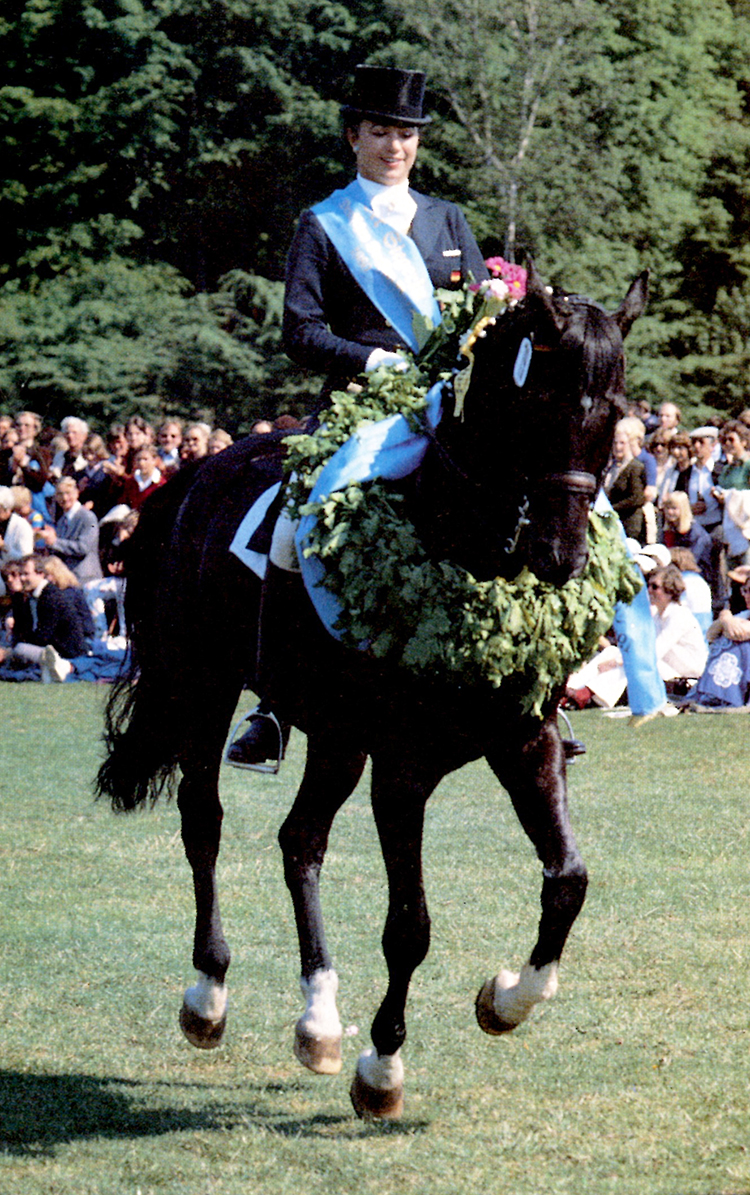
Gabriela and Ultimo
Conclusion
The subject Kür has led us from philosophy through history into practice. The accent is to ride the test in the classical way to music. One should never forget that the Kür works towards the symbol of the centaur – the symbol of ultimate harmony between horse and rider.
International Horse Breeders offers Australian Breeders the best European Bloodlines, see the range of stallions at www.ihb.com.au
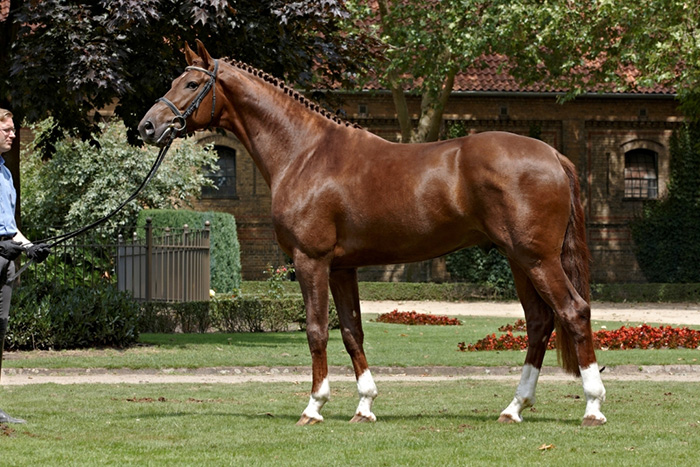
Vitalis
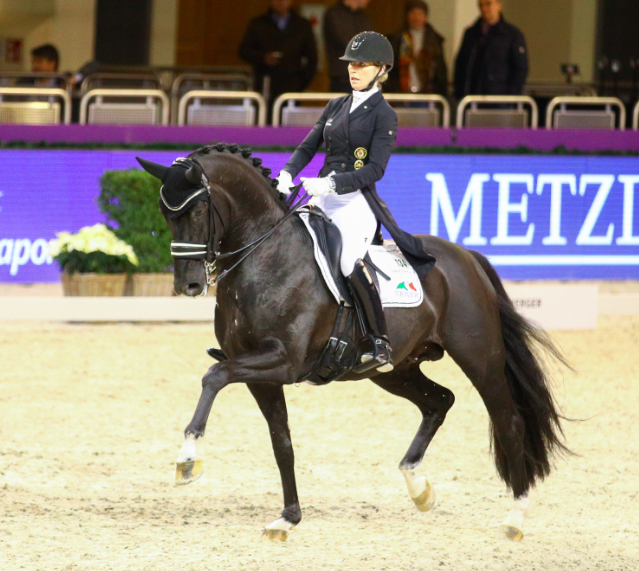
Total Hope
